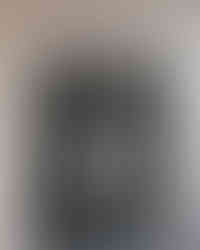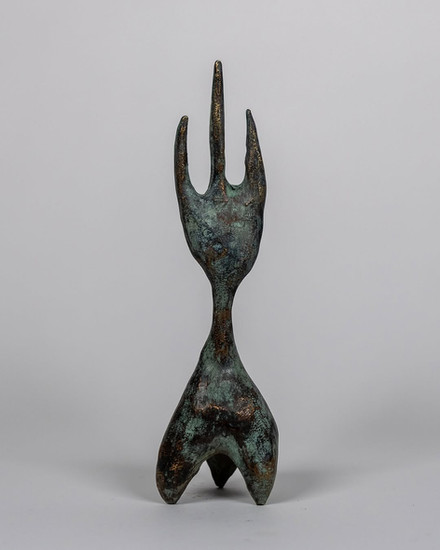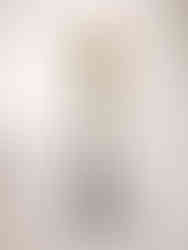Sol Bailey Barker : Ritual Relics
- Christopher McCrory

- Oct 7
- 4 min read
Sol Bailey Barker is a London-based multidisciplinary artist whose work digs deep—literally and metaphorically—into the layers of history, mythology, and material memory. Through sculpture, installation, sound, and performance, Sol channels a practice that feels both ancient and futuristic, sacred and raw. Working with bronze, stone, and found objects, his pieces often read like artefacts from an alternate timeline—ritualistic relics reimagined for modern mythology.

Influenced by archaeology, indigenous technologies, and ancestral narratives, Sol's work examines the relationship between power, memory, and the environment. His installations often occupy space like altars—blending industrial forms with organic resonance, and inviting the viewer into a meditative confrontation with time.
Whether exhibited in white cube galleries or abandoned landscapes, Sol’s creations ask big questions: about survival, spirituality, and the human need to connect with something greater than the self. His practice is also collaborative, engaging with activists, thinkers, and musicians to build a multidimensional world that’s tactile, political, and transcendent.

Your work often feels mythological—do you see yourself as a storyteller?
I’m seeking, through my sculptural installations, to tell an alternate story—one that counters the myths perpetuated by mainstream society. If we can shine light on the scars of the past and imagine a better future, we can begin to make it real. The world we live in is built on a narrative that’s collectively woven. By amplifying the voices of beings and perspectives often overlooked, we can be reminded that a truly symbiotic life is not only possible—it’s essential.
How do you choose your materials, and what role does their history play?
Materials are central to my practice—they carry an inherent nature and power. The wood of an ancient, storm-fallen tree holds the memory of having witnessed the world; it’s a living archive. Mirror-polished stainless steel, on the other hand, speaks to the evolution of technology—of machines, of crafts of the air and sea, of robotics. But it also evokes metallurgy and alchemy: the transformation of one form into another.
Where do archaeology and art overlap for you?
For me, archaeology is intertwined with anthropology—an exploration of how people live, worship, and relate to the world. Take Göbekli Tepe, the oldest known temple in the world, dating back 12,000 years. Its discovery pushed our understanding of complex society and sacred architecture back by 6,000 years. It reveals a profound connection to the cosmos and the cycles of nature.
There’s a strong spiritual presence in your work—do you consider your art ritualistic?Yes, the process of creation is always a ritual for me. It demands everything—I become a vessel, a channel. What emerges is often as much a surprise to me as to anyone else. The subconscious realm is just beyond our reach. As Jung documented, the collective unconscious holds a world of beings and stories waiting to unfurl.

How does sound interact with your sculptural practice?
Sound is often an integral layer of my installations. It might be recordings from landscapes that inspired the work, sonic compositions made from the sculptures themselves, or spoken narratives exploring the dreams behind the piece. Sound deepens the immersion—it pulls you into the emotional and mythological space the work occupies.
What’s your relationship with land and place when making work?
Site-specificity is essential. I often create sculptures near the places they’ll inhabit, using materials found nearby. This allows the forms and textures to echo the geography of the land. For my current exhibition Pansentient Arboriculture at Proposition Bethnal Green, I’ve been working with ancient storm-fallen trees from Sussex, where I grew up. One of the yew pieces came from Wakehurst—planted in 1600 when the manor was built. These materials carry deep time within them.
Do your pieces ever take on a life of their own?
Absolutely. Recently, when I walked into my studio, it felt as if the sculptures had just stopped moving—like they’d been making mischief in my absence. Some feel commanding, others playful. Once a piece leaves me, it begins a new life. People live with the works as altars, mirrors, companions—each with their own story, entirely separate from mine.
What role does collaboration play in your practice?
I love collaborating with people who bring skills I don’t possess—it amplifies a shared vision. But perhaps my greatest collaboration is with the materials themselves. Wood and stone have their own identity from the beginning. With steel or plaster, a kind of momentum takes over. I often feel the work is guiding me. Beyond that, the energy I channel is universal—so in a sense, I’m collaborating with the cosmos.

How do you navigate making work that feels both ancient and futuristic?
There’s a myth, especially in the West, that everything began with the Enlightenment. But ancient knowledge—of mathematics, cosmology, medicine—has existed for millennia in Africa, India, Latin America, and beyond. Libraries were burned to erase this wisdom: Alexandria, Nalanda, the Mayan codices. Our future depends on honouring and integrating these ancestral technologies and ways of being. Done right, this ancient futurism can guide us toward healing. But if we blindly continue down the path of industrial feudalism, we risk losing everything. I still believe we can change course.
What’s next for you?
I’m currently part of In Good Company at Lamb Gallery, Mayfair (on until 1 July 2025). My solo show Pansentient Arboriculture opens on 25 April at Proposition, Bethnal Green and runs until 7 June. This body of work explores the central role of trees in our wellbeing and long-term survival. Formed from tree trunks, the sculptures bring organic textures into dialogue with Albion’s mythologies. They honour the material and spiritual life of trees—and the deep entanglement between human and arboreal existence.





















Comments